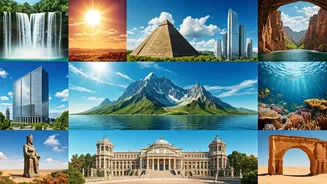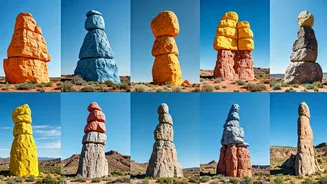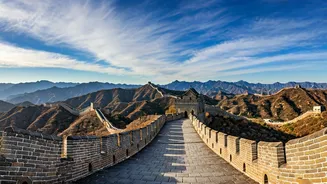The Great Pyramid
The Great Pyramid of Giza, a timeless testament to human ingenuity, stands as the oldest of the Seven Wonders of the Ancient World. Constructed over 4,500
years ago during the reign of Pharaoh Khufu, this immense structure served as his final resting place. The pyramid's colossal size, precise alignment with cardinal directions, and intricate internal passages reflect the advanced engineering and organizational skills of the ancient Egyptians. Its smooth limestone casing, once gleaming in the sun, has weathered the test of time, yet the pyramid's enduring presence continues to inspire wonder and fascination.
Hanging Gardens of Babylon
Legend speaks of the Hanging Gardens of Babylon, a verdant oasis reportedly built by King Nebuchadnezzar II for his homesick wife. Though their actual existence remains debated among historians, the gardens are described as a marvel of engineering, featuring tiered platforms filled with lush vegetation, watered by an intricate irrigation system. This ambitious creation was meant to recreate the mountains of Media, offering a tranquil escape within the bustling city. This legendary marvel epitomizes the human desire to transform the environment and create a haven of beauty.
The Statue of Zeus
In the city of Olympia, the Statue of Zeus was a monumental work of art. Crafted by the sculptor Phidias in the 5th century BC, it depicted the king of the gods seated on a throne, made of ivory and gold. The statue, towering over 40 feet tall, was housed within the Temple of Zeus, attracting pilgrims from across the ancient world. The statue's significance lay not only in its artistic grandeur but also in its representation of religious beliefs and cultural values. Though destroyed long ago, its legacy continues to resonate.
Temple of Artemis
Dedicated to the Greek goddess Artemis, the Temple of Artemis at Ephesus was a grand testament to the goddess of the hunt. This temple, located in modern-day Turkey, was rebuilt multiple times, each iteration more opulent than the last. Famous for its marble columns and impressive size, the Temple of Artemis was a symbol of wealth, power, and religious devotion. The temple's destruction and reconstruction demonstrate the enduring importance of religious sites in ancient societies, and its ruins continue to captivate visitors.
The Mausoleum
The Mausoleum at Halicarnassus was an elaborate tomb built for Mausolus, a satrap in the Persian Empire, and his sister-wife Artemisia II of Caria. This monumental structure, which gave us the word 'mausoleum,' was a blend of Greek, Egyptian, and Lycian architectural styles, showcasing the cultural diversity of the time. Adorned with sculptures by some of the most famous artists of ancient Greece, the mausoleum was a testament to the wealth and power of its patrons. Though damaged by earthquakes, its ruins provided insight into ancient funerary practices.
The Colossus of Rhodes
Standing guard over the harbor of Rhodes, the Colossus of Rhodes was a bronze statue of the sun god Helios. Constructed in the 3rd century BC, it was a symbol of the island's unity and power after a long siege. The statue's colossal size and intricate design, including a complex internal support system, made it an engineering marvel. It only stood for a few decades before being toppled by an earthquake, yet the Colossus of Rhodes is remembered as an emblem of artistic and engineering achievement.
Lighthouse of Alexandria
The Lighthouse of Alexandria, built on the island of Pharos, guided ships into the bustling harbor of Alexandria. Completed around 280 BC, it employed mirrors to reflect sunlight during the day and a fire at night, making it one of the tallest structures of its time. Its innovative design, including a series of ramps and a sophisticated lighting system, ensured its visibility from great distances. The lighthouse served as a beacon of progress and technological innovation, facilitating trade and cultural exchange.
Christ the Redeemer
Towering over Rio de Janeiro, Brazil, the Christ the Redeemer statue is a modern wonder that embodies faith and resilience. Completed in 1931, the statue stands atop Corcovado Mountain, with its arms outstretched in a welcoming gesture. The statue's blend of art deco style and religious symbolism has turned it into a globally recognized icon, symbolizing peace and hope. It also offers breathtaking panoramic views of the city, becoming an essential destination for tourists.
The Great Wall
Stretching thousands of miles across northern China, the Great Wall is a colossal fortification. Constructed over centuries, the wall's primary purpose was to protect the Chinese Empire from invaders. The wall’s construction used a variety of materials, including stone, brick, and packed earth, and its design adapted to the natural terrain. The Great Wall is not just a defensive structure, but a testament to human endurance, strategic planning, and the organizational capacity of imperial China. It stands as a powerful symbol of China's history and enduring cultural heritage.











